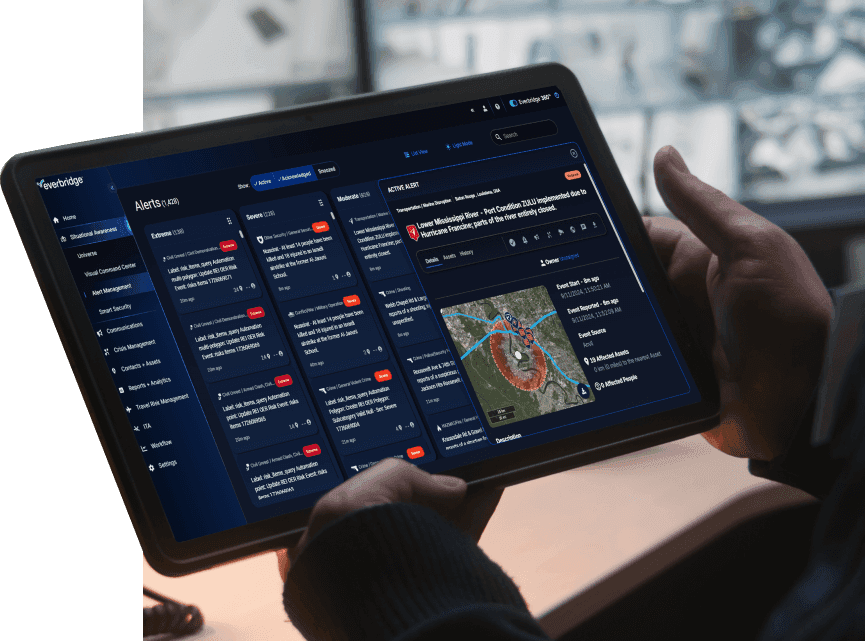Protect your global workforce with Everbridge Assist. This comprehensive service provides 24/7 medical, security, and travel assistance for any event impacting your employees’ well-being. Powered by integrated technology and a global support network, we ensure rapid, expert care to maintain safety and business continuity during any disruption or emergency.
Resource page description: Protect your global workforce with Everbridge Assist’s 24/7 support, ensuring safety and continuity with integrated technology and expert global assistance.
Discover how Ameren leverages Everbridge to stay resilient during Midwest weather disruptions and ensure regulatory compliance for nuclear facilities. From location-based notifications with maps to customizable forms for external stakeholders, Everbridge transforms how Ameren handles critical events.
Full video transcript
[00:11.4]
Everbridge has changed the way my team responds to disruptions and critical events in a variety of ways. One way I can think of is, we tend to have bad weather in the Midwest. Inclement weather, whether it’s like, tornado season, whether it’s fire season, or even in the winter.
[00:31.5]
It always kind of poses, challenges operationally and also just for coworkers trying to get to their work center.
[00:44.9]
One thing that happened this winter was that there was a massive, snow and ice storm and business segments were scrambling, trying to figure out who was going to be able to be remote, who was going to be able to work where. And Everbridge really came in key there because there’s a really nice function, with their incidents and notifications that allows you to kind of create an ad hoc HTML, little web page.
[01:08.8]
And that page you can actually add valuable, visual information like maps. So we were able to utilize this function and send texts to key, employees at specific locations, because Everbridge also allows you to put in specific location information for employees.
[01:27.2]
So we were able to target the employees who work at specific places and then send them key information just pertinent to them so they knew, where was safe to drive and where wasn’t, and it also kind of helps other employees know, okay, if we sent you a certain message, you don’t report to work.
[01:44.9]
But if we sent you this message with maps and information, then you know exactly how to get to work and exactly where to park and where the safe spots are.
[01:57.5]
The one way Everbridge has helped my organization stay resilient is just how customizable it is to situations that might happen to differt business segments. One such time is we support, nuclear facilities, and one of the nuclear facilities needed to find a way to send customizable information to external stakeholders that needed to be received in a very specific amount of time and acknowledged in order to maintain, regulatory compliance with their governing body.
[02:32.3]
So through Everbridge we were able to engage some professional services and build out really, really complex forms that had various ways to input information. So they were like dropdown toggles. There was a place for manual input, and it was great because it allowed them to achieve the level of granularity that was necessary.
[02:53.8]
And then send that to external stakeholders who were simply able, type like yes, or whatever they needed, to respond within the allotted time. This was vastly different than the system that they were using before, in the best possible way. We could see that data visualized exactly when people responded, who responded.
[03:13.1]
And we had the flexibility to send it to, specific people within an organization. So it was just incredible. The nuclear team is using it and they’re loving it. And we are constantly in conversations about how we can further expand.
Full video transcript
[0:08.5]
BCIC helps us stay resilient by allowing us to have all of our information in a single repository. We can track our BIAs and tie that into our business continuity plans. All the information is relational, so we don’t have to retype in any information.
[0:29.3]
It’s all just, this is associated with that, and we’re good to go. I would advise anyone that’s trying to do a business continuity program with the manual process is to give it up. There are so many advantages of having a application that’s a business continuity management system that can help you manage your program.
[0:53.0]
It’s just, it saves you double your staff in efficiency. BCIC, just a real world example of how it was beneficial to us, and this is fairly simple, but we have a big migration going on from JDE World to JDE E1.
[1:12.7]
And this is going to cause a momentary interruption in our processes, in our application, which is at the core of our business. And they wanted to know which business processes are impacted by the loss of that application and the boundary applications for JDE World and E1.
[1:36.6]
And we were able to create a report in a matter of 30 minutes that says here’s those processes that are impacted by this interruption.


